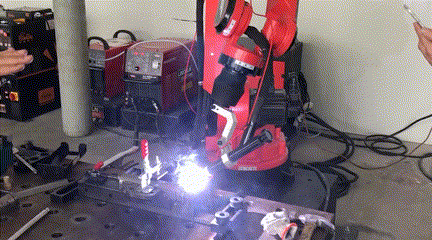
1. Correct selection of welding parameters
(1) Welding current and arc voltage In CO2 gas shielded welding, for each diameter of welding wire, there is a certain law between the spatter rate and the welding current. In the short-circuit transition zone of small current, the welding spatter rate is small. After entering the fine particle transition zone of high current, the welding spatter rate is also small, and the welding spatter rate is the largest in the middle zone. Taking a wire with a diameter of 1.2 mm as an example, when the welding current is less than 150A or greater than 300A, the welding spatter is small, and between the two, the welding spatter is large. When selecting the welding current, the welding current area with high welding spatter rate should be avoided as much as possible, and the appropriate arc voltage should be matched after the welding current is determined.

(2) Welding wire extension length: The welding wire extension length (ie dry elongation) also has an effect on the welding spatter. The longer the welding wire extension length is, the larger the welding spatter is. For example, for a wire with a diameter of 1.2mm, when the welding current is 280A, when the extension length of the wire increases from 20mm to 30mm, the amount of welding spatter increases by about 5%. Therefore, it is required that the extension length of the welding wire should be shortened
2. Improve the welding power source
The cause of the splash in CO2 gas shielded welding is mainly in the final stage of the short-circuit transition, due to the sharp increase of the short-circuit current, the liquid bridge metal is rapidly heated, resulting in heat accumulation, and finally, the liquid bridge bursts to generate splashes. Considering the improvement of the welding power source, methods such as the series connection of reactors and resistors, current switching, and current waveform control in the welding circuit are mainly used to reduce the burst current of the liquid bridge and thus reduce the welding spatter. At present, thyristor-type wave-controlled CO2 gas shielded welding machines and inverter-type transistor-type wave-controlled CO2 gas shielded welding machines have been used, and have achieved success in reducing the spatter of CO2 gas shielded welding.
3. Add argon (Ar) to the CO2 gas:
After adding a certain amount of argon gas to CO2 gas, the physical and chemical properties of CO2 gas were changed. With the increase of argon gas ratio, the welding spatter gradually decreased, and the most significant change to the spatter loss was when the particle diameter was greater than 0. 8mm spatter, but has little effect on spatter with particle diameter less than 0.8mm.
In addition, the use of mixed gas shielded welding in which argon is added to CO2 gas can also improve the weld formation. The effect of adding argon to CO2 gas on the weld penetration, fusion width and residual height, with the argon in CO2 gas. As the gas content increases, the penetration depth decreases, the fusion width increases, and the weld height decreases.
4. Use low spatter welding wire
For solid wire, on the premise of ensuring the mechanical properties of the joint, reducing the carbon content as much as possible, and appropriately increasing alloying elements such as titanium and aluminum can effectively reduce welding spatter.
In addition, the use of flux-cored wire CO2 gas shielded welding can greatly reduce welding spatter, and the welding spatter produced by flux-cored welding wire is about 1/3 of that of solid-cored welding wire.
5. Control of welding torch angle:
When the welding torch is perpendicular to the weldment, the least amount of welding spatter is produced, and the greater the angle of inclination, the more spatter. When welding, the inclination angle of the welding torch should not exceed 20º.
Post time: Jun-22-2022




